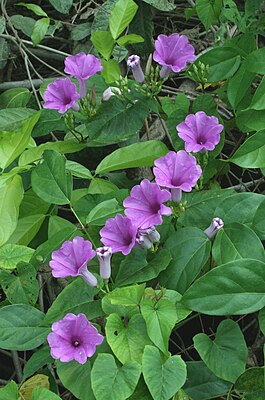Ipomoea squamosa
| Ipomoea squamosa | ||||||||||||
|---|---|---|---|---|---|---|---|---|---|---|---|---|

Ipomoea squamosa |
||||||||||||
| Systematics | ||||||||||||
|
||||||||||||
| Scientific name | ||||||||||||
| Ipomoea squamosa | ||||||||||||
| Choisy |
Ipomoea squamosa , a German trivial name is Common morningglory is a plant from the genus of Morningglory ( Ipomoea ) in the family of wind plants (Convolvulaceae). It is common in the Neotropics .
description
Vegetative characteristics
Ipomoea squamosa is a twining, herbaceous or semi-shrubby climber .
The alternate leaves are arranged in a petiole and a leaf blade. The leaf stalk is slender, tomentose or hairless. The leaf blades are 6 to 12 cm long, 3 to 8 cm wide, triangular, arrow-shaped, ovate-heart-shaped or long, pointed. The lateral leaf lobes are protruding and somewhat pointed. Both leaf surfaces are hairless to sparsely or densely hairy silky.
The inflorescences are usually longer than the surrounding leaves. They are mostly compact, little to ten-flowered cymes with an inflorescence stalk up to 10 cm long. The flower stalks are accompanied by bracts , are slender and up to 1 cm long.
Generative characteristics
The hermaphrodite flowers are five-fold with a double flower envelope . The sepals are leathery, glabrous, unevenly shaped, egg-shaped to almost circular. The tip is rounded or cut off, the edge is scaly. The outer sepals are about 5 mm long, the inner about 1 cm. The bald crown is funnel-shaped, pink to purple in color and (rarely only 4) 7 to 8 cm long. The five stamens are set near the crown base and about 2 cm long.
Locations
Ipomoea squamosa grows from swampy thickets and forest edges at sea level to mountain forests and thickets at altitudes of up to 2100 meters.
Systematics and distribution
The first description of Ipomoea squamosa was made in 1845 by Jacques Denys Choisy in Alphonse Louis Pierre Pyramus de Candolle : Prodromus Systematis Naturalis Regni Vegetabilis , Volume 9, pp 376-377.
Ipomoea squamosa is distributed from Mexico across all of Central America to South America .
There are two varieties of Ipomoea squamosa :
- Ipomoea squamosa Choisy . Var squamosa (syn .: Ipomoea Callida House , Ipomoea mattogrossensis . K.Schum , Ipomoea morelii .. Duchass & Walp , Ipomoea trinitensis Urb. Ipomoea wilsonii House , Ipomoea squamosa var. Petiolaris Meisn. ): It is of Mexico spread across Central America to tropical South America.
- Ipomoea squamosa var. Villosa Ooststr. : It occurs in Peru and Brazil.
swell
literature
- Paul C. Standley, Louis O. Williams: Convolvulaceae . In: Paul C. Standley, Louis O. Williams, and Dorothy N. Gibsons (Eds.): Flora of Guatemala. In: Fieldiana: Botany , Part IX, Numbers 1-4, 1970-1973.
Individual evidence
- ↑ Eckehart J. Jäger, Friedrich Ebel, Peter Hanelt, Gerd K. Müller (eds.): Rothmaler - Exkursionsflora von Deutschland. Volume 5: Herbaceous ornamental and useful plants . Spectrum Academic Publishing House, Berlin Heidelberg 2008, ISBN 978-3-8274-0918-8 .
- ^ Ipomoea squamosa at Tropicos.org. Missouri Botanical Garden, St. Louis, Retrieved November 25, 2018.
- ↑ a b c d Rafaël Govaerts (Ed.): Ipomoea squamosa. In: World Checklist of Selected Plant Families (WCSP) - The Board of Trustees of the Royal Botanic Gardens, Kew . Retrieved November 25, 2018.
- ^ A b Ipomoea squamosa in the Germplasm Resources Information Network (GRIN), USDA , ARS , National Genetic Resources Program. National Germplasm Resources Laboratory, Beltsville, Maryland. Retrieved November 25, 2018.
Web links
- Ipomoea squamosa at Tropicos.org. In: 83 . Missouri Botanical Garden, St. Louis
- Ipomoea squamosa at Tropicos.org. In: Flora Mesoamericana . Missouri Botanical Garden, St. Louis
- Ipomoea squamosa at Tropicos.org. In: Flora of Panama (WFO) . Missouri Botanical Garden, St. Louis
- Ipomoea squamosa at Tropicos.org. In: 66 . Missouri Botanical Garden, St. Louis
- Ipomoea squamosa at Tropicos.org. In: Flora de Nicaragua . Missouri Botanical Garden, St. Louis